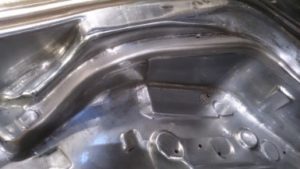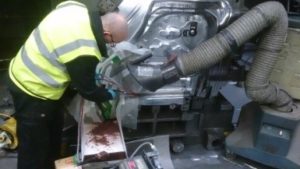
Plastics molders, operating both captive and job shops, are frequently plagued with downtime due to repairs that must be made on damaged or worn mold components. Typical repairs include damaged cavities, worn gate areas, and parting lines that cause flashing of molded parts.
Conventional machine shop practices commonly employed to repair plastics molds share a serious drawback— they all require that the mold be removed to carry out the needed repair. For larger repairs, the part must often be sent to a facility that uses tank electroplating. In-situ selective plating allows the repair of molds, reducing downtime substantially.
Selective Plating Process. Mold/die costs vary widely depending on size, materials and origin. With costs ranging from tens of thousands of dollars up to millions for large automotive part dies, the last thing a producer wants to do is buy new tooling. Just the cost of removing a mold from the machine for outside repair is substantial, and the cost of lost production is greater still. This makes typical in-situ plating repairs for a one-day job a very attractive option. These costs vary depending on the size and depth of the mold area needing repair.
As a general rule, defect depths of up to about 0.060” are good candidates for this type of repair.

If a mold has a lot of corrosion, scratches and other small surface flaws that result in a poor finish on the molded part, the temptation may be to remove the tooling and send it out for tank electroplating. However, selective plating can take care of these flaws in place, without extensive masking, and is significantly faster than tank electroplating.
What’s more, selective plating equipment is portable, enabling the operator to meet plating and buildup requirements wherever they arise. The molds used in many high-end products such as automobiles have become increasingly expensive and have long lead times due to offshore manufacturing. Therefore, it becomes critical to be able to quickly repair defective components, rather than replacing them or delaying repair by removing them from the machine, shipping them out for repairs and waiting for their return. Taking a mold out of service for an extended time is often not an option.
In addition to in-place defect repairs, there are several other applications in which selective plating provides a quick and lower-cost means of returning critical components to service.
Resizing Core Pins and Bushings. As wear occurs and pin and bushing dimensions deviate from accepted tolerances, it becomes necessary to discard and replace core pins and core bushings. With the accurately controlled selective plating process, these parts can be quickly plated back to size and put in service, often without finish machining. Nickel and Cobalt are excellent choices for selective deposition in these applications, since they have good toughness characteristics, in addition to excellent wear resistance. If a harder surface is required, nickel-tungsten, nickel-cobalt, and cobalt-tungsten alloys may be selectively deposited in a hardness range of Rockwell C 60 to 68.
Flash Correction. Worn gate areas or damaged parting lines may be repaired to eliminate flashing by the use of selective plating. After the amount of wear in the gate area is measured, the digital ampere-hour meter is used to control the amount of metal deposit needed to resize the gate precisely without the need for subsequent machining. Chipped or damaged parting lines are repaired in similar fashion.
Machine Maintenance. Many plastics molders who utilize the selective plating process for mold repair have found the process equally useful in press or machine maintenance. Scores or scratches in chromed hydraulic actuating cylinders are filled with copper and then capped with nickel or cobalt. Again, this repair is performed without disassembling the cylinder from the press and without the need to strip and re-plate chrome. Worn shafts and journal areas may be resized rapidly by the selective plating process. Totally round and concentric bearing fits are obtainable by selective plating.
Selective plating is a cost-effective mold component repair technique for a broad array of applications. It can often be accomplished without removing parts from production machinery, and can be completed in a matter of hours.

 Chinese (Simplified)
Chinese (Simplified)  English (UK)
English (UK)  French
French  German
German  Spanish
Spanish  Swedish
Swedish 